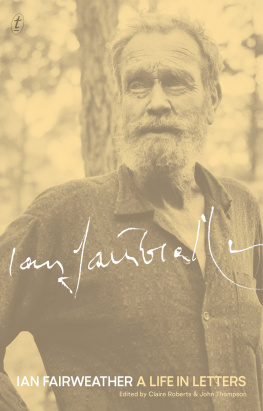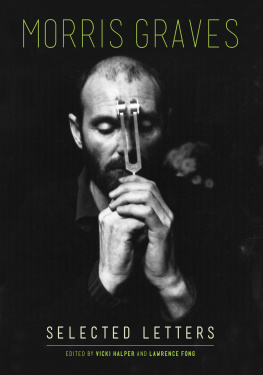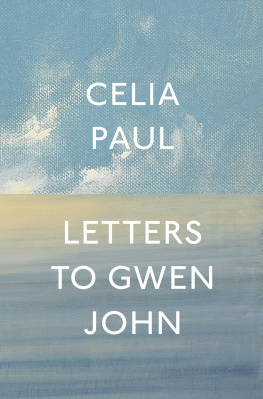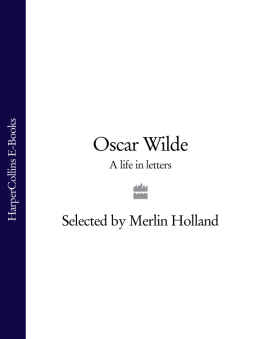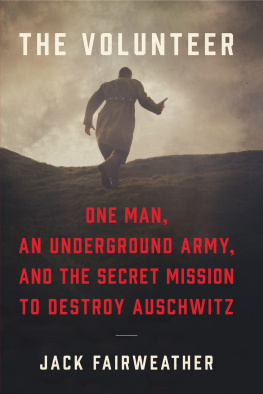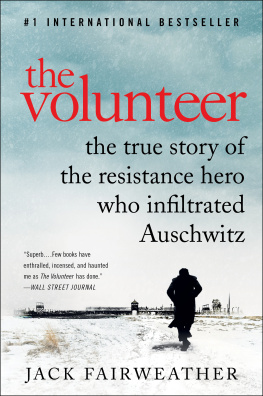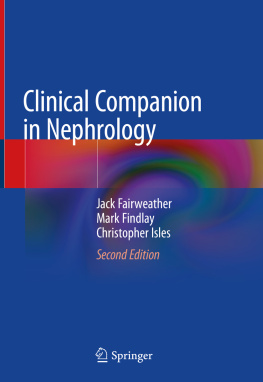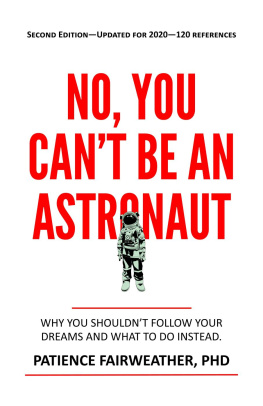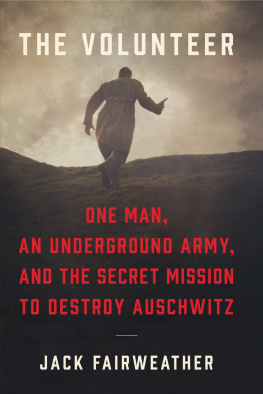
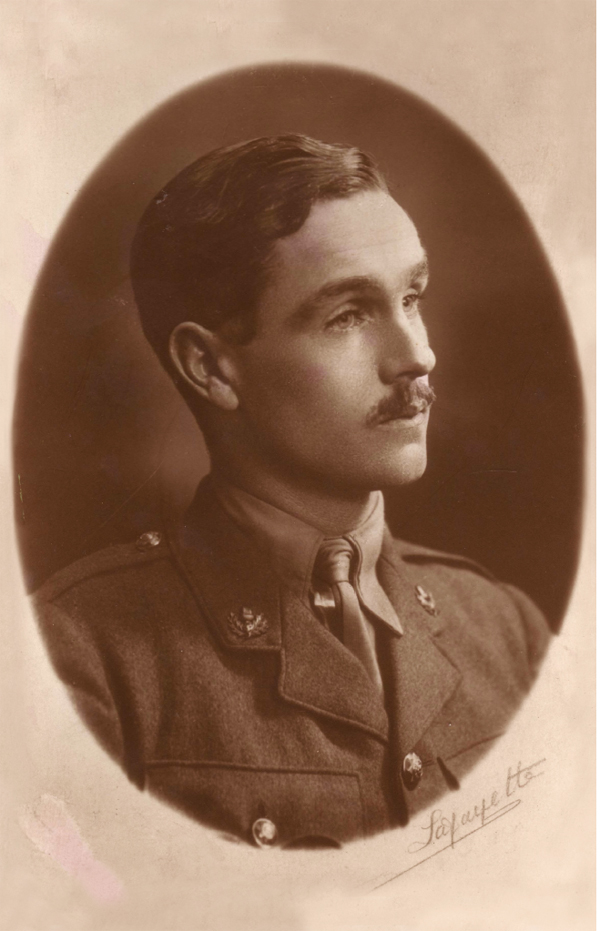
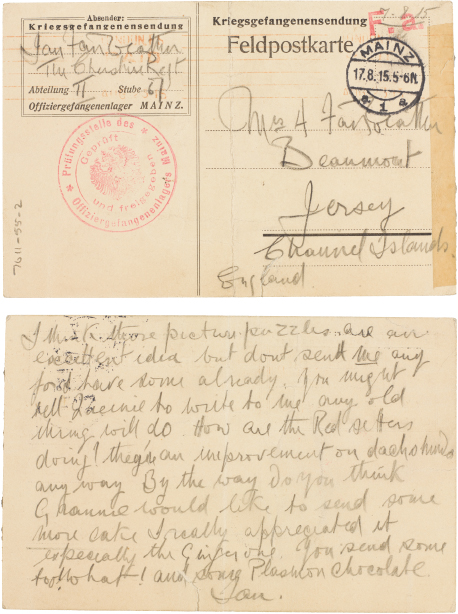
Above: Postcard, Ian Fairweather to Annette Fairweather (his mother), from POW camp in Mainz, Germany, 7 August 1915. National Army Museum, London. Fairweather Estate. Letter 1. Opposite: Lafayette Photography, Ian Fairweather, Second Lieutenant, Land Forces, 1st Battalion, Cheshire Regiment, 1914. Gelatin silver print. Fairweather collection. Courtesy Fairweather Estate.

Ian Fairweather, The Subalterns Shed, Torgau, c. 1914. Watercolour, ink and gouache over pencil on thick cream wove paper. 14.5 x 11.2 cm. Purchased 1983 with the assistance of the Philip Bacon Galleries. John Darnell Bequest. Queensland Art Gallery | Gallery of Modern Art, Brisbane. Ian Fairweather / DACS. Copyright Agency, 2019.
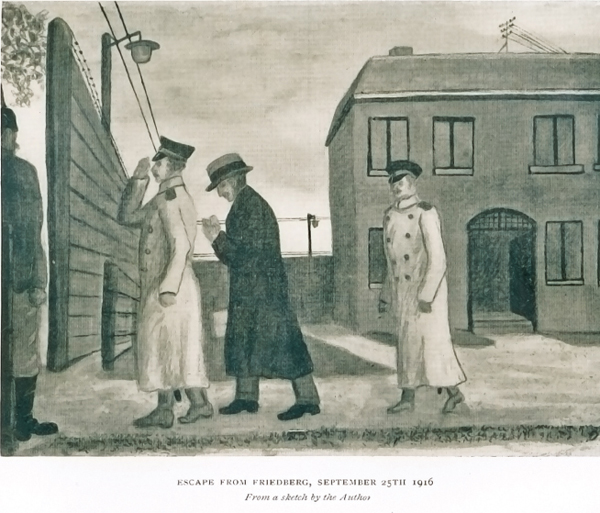
Duncan Grinnell-Milne, Drawing of Grinnell-Milnes escape from Friedberg POW camp dressed in a German uniform, with his brother Douglas and Ian Fairweather (right), 25 September 1916. Duncan Grinnell-Milne, An Escapers Log (1926). (See letter 281.)

Ian Fairweather, Tea Garden, Peking, 1936. Oil on cardboard. 86.4 x 88.8 cm. Art Gallery of New South Wales, Sydney. Purchased with funds provided by the Art Gallery Society of New South Wales, 2004. Ian Fairweather / DACS. Copyright Agency, 2019. (See letters 13, 112.)
7 AUGUST 1915 1 SEPTEMBER 1938
ON HIS second day of war service, the twenty-three-year-old Ian Fairweather, Second Lieutenant, Land Forces, 1st Battalion, Cheshire Regiment, faced action. His regiment was shelled by high explosives and shrapnell during the Battle of Mons, an attempt to hold the line of the Mons-Cond Canal, near Dour, France, in the first major engagement of the British Expeditionary Force of the Great War. Against the numerically greater power of the German 1st Army, the British were forced to retreat, and the regiment was surrounded and captured. Fairweather became a prisoner of war, first in Torgau and Mainz, and later in the camps of Friedburg, Ingolstadt, Crefeld and Strhen.
During his imprisonment he contributed drawings to POW magazines and read books on Japanese and Chinese art. His four-year incarceration included lengthy periods of solitary confinement as a result of repeated escape attempts. After his release in a prisoner exchange, he studied art at The Academy in The Hague and privately with the painter Johan Hendrik van Mastenbroek, working with him in his studio and painting and sketching en plein air in the Dutch countryside. Later he studied under Professor Henry Tonks at the Slade School of Art, London. Tonks was a formidable and demanding teacher but in Fairweather he had a serious student. While at the Slade, Fairweather was awarded Second Prize for Figure Drawing, his first early success. Photographs of Fairweather from this time suggest that the experience of war and imprisonment had taken a huge emotional toll.
Restless, he travelled in Germany and Norway, painted in Hertford, and worked as a labourer and then a caretaker in Canada before boarding a ship to Shanghai. After more than three years in China, determined to keep painting, he set out for Australia. On the way he spent nine months in Bali then, after landfall in Broome, reached Fremantle. Finding the place so awful, he quickly took the next boat to Colombo where, with insufficient funds, he was not permitted to land. He later returned to Australia, arriving in Melbourne in early 1934. There local artists organised an exhibition and assisted in finding studio space. But before the year was out Fairweather left again, travelling by boat to Davao in the Philippines, then on to Peking. He then travelled back through East and South-East Asia. Once more with little money, he had difficulty in landing in any of the Asian ports; briefly he suffered the indignity of a prison stay in Jakarta.
He finally settled for a time in Zamboanga, where he built his first studio, and later in Manila. With the help of his old Slade friend Jim Ede, Fairweathers Bathing Scene, Bali (1933) was acquired by the Contemporary Art Society and presented to the Tate Gallery. Paintings created in China and the Philippines were included in regular group and solo exhibitions at the Redfern Gallery, London, where they attracted favourable reviews and brought in much-needed funds. After periods in non-English-speaking countries and conscious of being a poor white man in Asia, Fairweather again reconsidered his prospects in Australia.
1. To Annette Fairweather
I think those picture puzzles are an excellent idea but dont send me any for I have some already. You might tell Queenie would like to send some more cake I really appreciated it especially the Ginger one. You send some too! What! and some Plasmon chocolate.
Ian
Annette Margaret Dupr Fairweather (ne Thorp, 18521944). Mother of Ian Fairweather, born in Simla, India, the third child of Edward Thorp, Surgeon General, Indian Medical Service, and Sarah Meadows (ne Nicholson). In August 1871 in Simla, Annette married James Fairweather (18281917), medical officer, 4th Punjab Infantry, later Surgeon General, Indian Medical Service.
_____________
German postcard: Absender (Sender): Kriegsgefangenensendung (POW mission), Ian Fairweather, The Cheshire Regt., Abteilung (Department) II, Stube (Room) 67, Offiziergefangenenlager (Officer prison camp), MAINZ; Kriegsgefangenensendung (POW mission), Feldpostkarte (Field postcard); to Mrs A. Fairweather, Beaumont, Jersey, Channel Islands, England. Postmarked 17 August 1915.
Annette Waters (18841965), Fairweathers older sister, known in the family as Queenie, the seventh of nine children.
Sarah Thorp (18271916), maternal grandmother of Ian Fairweather. She had married Edward Thorp in Jullunder, Bengal, 13 July 1848.
2. To Jim Ede
Post Office Brithdir near Humboldt, Saskatchewan Canada [c. July 1928]
Dear Ede
I have just come across your letter which I got before leaving but had not the time to answer. No I regret that my people would not raise a finger to help towards anything to do with artand I beg you not to communicate to them in any way my addressfor though I hope to return home one day, I do not wish them to know of me any more
You say my inability to paint is you think due to nervesI think it isthat is why I dont wish to get in touch with my people againthey are so bitterly opposed to art. I feel their oppositionI had been longing for years to get away like this for a momentto have time to think things out a littleto reculer pour mieux sauterI dont suppose you will hear of any job I could get at home but if you dodo write to meI would get back somehow if I had to hobo itYrs.
Ian Fairweather
Harold Stanley (Jim) Ede (18951990). English-born museum curator and art collector who began his career as a painter at Newlyn and then in Scotland before war service interrupted his studies. He later received an ex-servicemans grant to study at the Slade School, where he first encountered Fairweather. He was a curator at the Tate Gallery in London, where he established contacts with avant-garde artists including Picasso, Braque and Chagall. Although a contender for directorship of the Tate, Ede resigned on health grounds in 1936. With his family he moved to Tangier but later settled at a home he named Kettles Yard in Cambridge, now a house museum attached to the university.
Next page
